Recently Kosovo has seen a surge in occupy movements. Not exactly like those in New York or Seoul, but with a more local identity. In Kosovo after the war there were many abandoned buildings. For most of them, the best the state could come up with was to make parking spaces, but in some cases when officials stretched their imaginations, ideas such as supermarkets or other commercial stores came up.
However, some people from Kosovo’s cultural sector decided that it would be better to intervene, so at least some of the buildings could be put to better use. In some cases they failed, like with the Union building near the National Theater, which was burned down and then sold and rebuilt as a commercial center. But in other cases, like the Jusuf Gervalla cinema in Peja and Kino Lumbardhi in Prizren, the fight continues, while Termokiss in Prishtina has recently entered this “bureaucratic dance” with state officials.
Lumbardhi was built in the ’50s but was officially left vacant for 16 years, from 1999 until 2015. At various times during that period it was used as a club for ex-workers and elderly people and an illegal coffee bar, while DokuFest began using it as a cinema in 2002. In July 2014 the Privatisation Agency of Kosovo (PAK) decided to liquidate it as a public property, and although not expressed, based on previous experience the intentions seemed clear — to turn it into a parking lot.
The cultural and artistic community of Prizren, rose to its defense, many giving all they have to stop the takeover happening. Today a large part of that burden is shouldered by Ares Shporta, who following the founding of the Lumbardhi Foundation in April 2015, was appointed as its executive director.
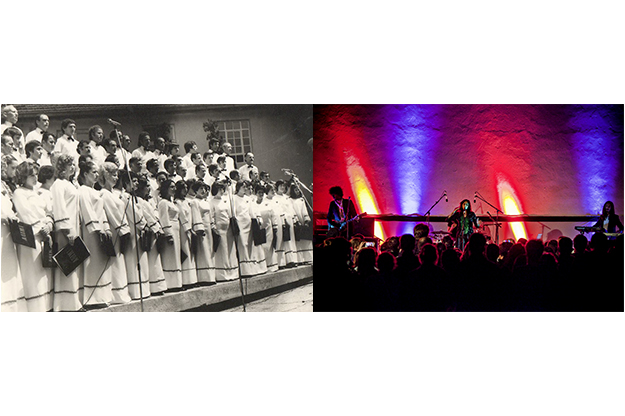
Prizren’s Kino Lumbardhi has been hosting cultural events since the ’50s. Today it is central to DokuFest. Photos: Courtesy of Lumbardhi’s archive (left), Majlinda Hoxha / K2.0 (right).
Although he has studied Business management in Istanbul Bilgi University, Shporta was always surrounded by, as he puts it, “artists, who either worked at DokuFest, or were musicians.”
A businessman with the heart of an artist, it was not until 2011 that he was truly engaged in a cultural event. In the Summer Urban Festival organized in Prishtina by Erzen Shkololli — the director of the National Art Gallery between 2011 and 2015 — Shporta was project assistant.
It was from this experience that Shporta drew his inspiration to organize a string of events in Istanbul, such as an exhibition with 10 artists, where local Kosovar musicians such as Shpat Deda, Genc Salihu, Gypsy Groove and Trio of Love performed, and later a concert by Petrit Ceku.
Since then, he has continued to grow. Following his appointment as executive director, the Lumbardhi Foundation team has carried out some basic works to make the old cinema habitable, and has set up a program of cultural activities — although currently on hold while construction works are carried out on the roof, the plan is to re-commence the program next month. “It is important not to lose the community and the circle of people that come here,” Shporta says.
There is much to be done in terms of reconstructing the place, the dull bureaucracy of regulation and the strenuous creativity in terms of program making. Shporta also believes that Lumbardhi’s image needs some PR, especially with the more conservative elements of Prizren’s population. Nevertheless, he feels confident, has the will to persist and the desire to see the process through.
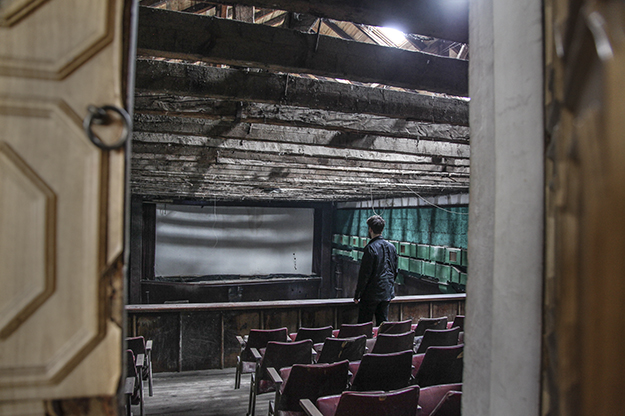
There is plenty of work to do on Lumbardhi’s historical building, but as the Lumbardhi Foundation’s executive director, Ares Shporta is determined to make the place a success. Photo: Majlinda Hoxha / K2.0.
K2.0 met with Shporta and asked about his interest in Kosovo’s cultural matters and his passion for reviving Kino Lumbardhi and turning it into a cultural hub for Prizren’s young people.
K2.0: When was the first time you came into contact with Lumbardhi?
Ares Shporta: My generation created a relationship with Lumbardhi more so through SHKA [Shoqëria Kulturoro Artistike — Cultural Artistic Society], which was an illegal cafe that functioned within Lumbardhi. Lumbardhi was in a way occupied since ’99. In 2012, a friend of ours functionalized it as a cafe, and it was very underground; some good vintage colors in there. It was a zone of complete freedom. It took you somewhere far away, from the middle of Prizren, from your own home.
SHKA enabled us to escape in an extraordinarily beautiful way, with colorful chairs, a beautiful yard, and with music that we liked, cheap drinks, and just youth who felt comfortable, with the gigs that we organized there; that’s how we connected with the place.
Naturally, because of DokuFest, we often got to see films there. We thought about what we could do with that place, because it was a pity that it was staying closed. This was way before the Privatization Agency announced its liquidation; we started thinking about it way before. It was wishful thinking in a way, based on earlier conversations that we had had.
From reports and reactions we know that problems with Lumbardhi had started long before. But which years were the most critical, and when did you decide to join this initiative?
In 2007, the municipality’s mayor wanted to demolish Lumbardhi. But then again DokuFest and [active citizenship NGO] Ec Ma Ndryshe and many other activists initiated a campaign, gathered 8,000 signatures, protested in the city, and blocked this wish expressed by the mayor. Actually, a few months later, the mayor lost in the elections and therefore lost power.
After that, nothing happened. It was saved, but it was still being used only sporadically, a few times during the summer, and that was it.
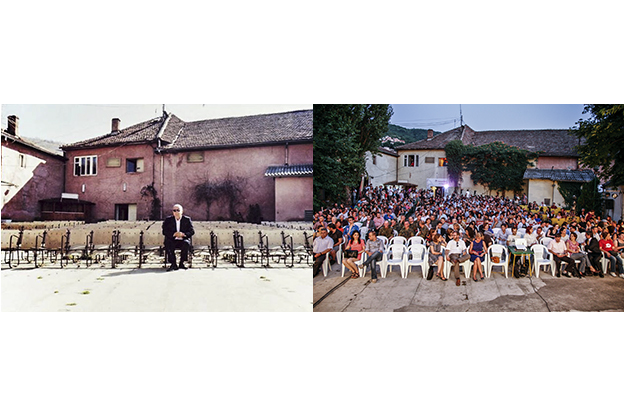
The historical outdoor cinema at Lumbardhi traditionally hosts DokuFest’s opening ceremony. Photos: Courtesy of Lumbardhi’s archive (left), Majlinda Hoxha / K2.0 (right).
In 2014, with the initiative [against the privatization of the cinema], which is a big issue in itself, in July we said that we have to do something. It didn’t matter if we won or lost; a reaction was needed — I was a part of a group of friends from DokuFest, Hajrullah [Ceku] from Ec Ma Ndryshe, and many other friends. We said, ‘OK, DokuFest opening is in three weeks — we’ll need to do something there. Then we’ll need to see how we continue with the initiative.’ Then at the DokuFest opening [that year] we wrote a very poetic text, and in front of 700-800 people, the director [Veton Nurkollari] came on stage.
On the other side you could see the DokuFest banner “Change, Don’t Hide,” and present in the audience were the president and the ministers of culture of two countries [Kosovo and Albania — respectively, Memli Krasniqi and Mirela Kumbaro], the mayor of the municipality, and PAK, and all the stakeholders. Veton, with 60-70 volunteers behind him, started to recite, against these declarations that the cinema would be taken away from us. DokuFest was made here, our dreams were made here, all of us had grown up here, and they wanted to take it from us; well we weren’t going to give it up. We would fight until the end, we would come together and we would make this possible.
On the last day of the festival there was a surprise visit from Edi Rama, and he wanted to go on stage.
Then the film “Everyday Rebellion” started, which is a film about all the Occupy movements around the world, and in that film the same thing was happening. They were protesting there as well, and in a way it was an echo of the protest that was held at the festival’s opening, at a time when usually thanks are given to sponsors, when everyone acts kindly, we turned on the authorities.
On the last day of the festival there was a surprise visit from Edi Rama, and he wanted to go on stage. He went out instead of [Kosovo’s] minister of culture and he gave an award for the international category, and said: “Mayors come and go, but if DokuFest goes, it doesn’t come back, and instead of becoming a parking lot, it must stay a cinema, and I hope that all authorities will act according to their responsibilities.”
How was this form of protest, including Edi Rama’s statement, met by the institutions? Were there reactions from society and civil organizations?
It was really funny because the next day everyone reacted — QKK [Kosovo Cinematography Center], PAK — and it offered an amazing opportunity, because we had to take the place back. At this point the Municipality of Prizren was cunning. They declared Kino Lumbardhi a zone of public interest, and simultaneously within that decision they inserted a clause to widen the road, the road next to which the cinema is located, which meant that they would automatically demolish the cinema.
Naturally we opposed that. At that point Hajrullahu took on a bigger role in that he analyzed the legal situation and what we could do. Kino Lumbardhi, like everything else, was a protected asset because it was in the historical zone, which has a law that protects it, but it was not on the protected heritage list itself. Kino Jusuf Gervalla [in Peja] was a heritage monument so we said, ‘OK, we can make Lumbardhi one too.’
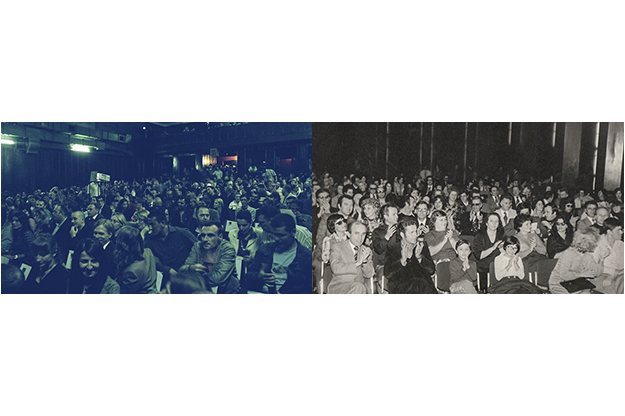
Kino Lumbardhi has been a cultural hub for many generations in Prizren. Photos: Courtesy of Kino Lumbardhi’s archive.
We were helped by a few colleagues of ours who worked in institutions with which we were close, but also other friends, and that group nominated Kino Lumbardhi for the cultural heritage list, filled in the paperwork, and made a group of 58 organizations that were part of the campaign.
This initiative came out with seven recommendations, saying “stop the liquidation,” “make a multi-stakeholder group” with representatives of institutions to discuss this and to find a long term solution, and to come up with a short term intervention; actually, all the steps that were necessary to take back Lumbardhi as a multi-functional cultural center. But this produced many results, and eventually we got the confirmation from the ministry that the cinema would be a part of the heritage list, and it happened three or four months later in January 2015.
PAK then informed us that the cinema was no longer up for liquidation, that the case was suspended for an unspecified period. And this was a great opportunity for us to try to utilize it, to start using the space, and to strengthen our cause, to win back that place, and to never leave it again. That was the idea.
So we said, ‘OK, this is the program for the year. We’re going to do concerts, exhibitions, lectures etc.’ We made a program in a very abstract way, went to PAK, who told us that if we do not talk badly about them in the media, and if we ensured the security of the building, they would give us a license to use the place, and on March 23, 2015, we got the keys to the cinema.
After you reached your initial objectives, what were your next steps?
Then we established the Lumbardhi Foundation, with the idea of continuing the work of the initiative; with a mandate for continuing the process with all institutional actors, and on the other hand consolidating the program and securing funds for restoration, or at least functionalization. Five members from the initiative established this organization, and I received the mandate as director of the organization.
In essence, this was my first work experience in a daily sense, and it was a very difficult case because we didn’t even have running water in the cinema; there was no electricity, it was a completely dilapidated building, it had all kinds of problems. The people in power in local authorities did not want it, it was unwanted heritage for many. They wanted to demolish it. It had a bad name. People didn’t like it because they had pornography [shows here] for a time [in the ’90s], there was plenty of speculation, and it was closed for a long time.
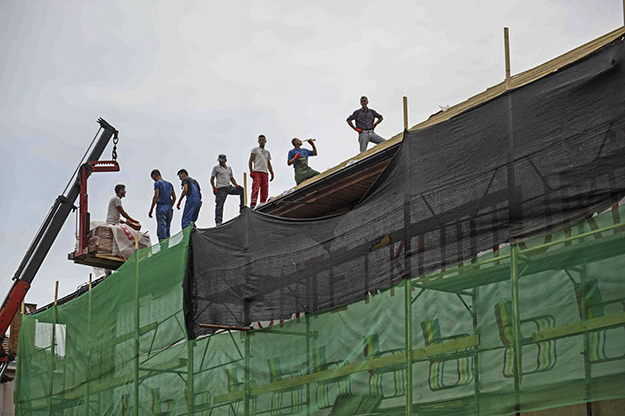
When the Lumbardhi Foundation took over the building, it was in a poor state of repair, but they have been working to regenerate it, including repairing the roof. Photo: Tughan Anit.
The relationship between that place and a part of the city was lost, albeit another part was very supportive. There were relations because of [cultural initiatives] Zambaku, DokuFest, Agim, because of their personal experiences, of collective memory. There were many layers within the issue that needed addressing, and we secured support from a private company, a few small sponsors, and we intervened in the building, functionalizing the administrative part.
What have you managed to complete so far at Lumbardhi, and what form is this space taking?
We have managed to build a vision for Lumbardhi. We’ve thought about how to involve citizens, neighbors, cultural organizations and even institutions — different parties. We’ve thought about what the future of this place should be. How can Lumbardhi be a new institution, an independent one, that can accommodate the different needs, of the scene and of citizens? Then, how must the space be organized, how must its memory be preserved? In a way, what can it contain?
We articulated these in a document called “Kino Lumbardhi Management Plan,” because Kino Lumbardhi is a heritage asset, and as such it needs a management plan. [The document] explains how it is an independent cultural space that accommodates film screenings, musical performances, public programs with conferences, a cooperative space and a space of memories, among other things. It explains how functional modality is conducted.
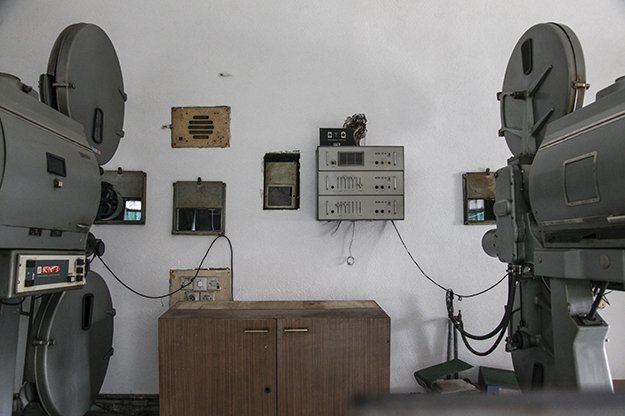
Shporta has helped to create a management plan for Kino Lumbardhi to help protect and embrace its rich heritage and to once again functionalize it as a cultural hub. Photo: Majlinda Hoxha / K2.0.
It is a place where people coproduce, cooperate, where different spaces are given to the youth, be it through Lumbardhi’s program or Lumbardhi’s spaces, which are useful to different parties. On the architectonic level, we have an idea about how this will be conducted, but this all requires financial means that are yet to be found. There is also a legal issue, because the ownership status of the cinema is yet to be regulated. The cinema continues to be under the jurisdiction of the Privatization Agency.
After almost two years of work we have managed to push the Ministry of Culture to send a request for expropriation, so that we could make Lumbardhi a state property under the administration of the Ministry of Culture, and after that happens, our aim is to utilize it for a longer period, and to have the opportunity to implement the vision that we have for it, and parallel with this, to secure the necessary support for preserving and adapting the spaces within the cinema.
Soon many young people will have to face government officials for their cultural organizations. As someone who has experience in a way with communicating with the bureaucratic apparatus, what would your advice be regarding more effective communication?
If what is given to us is not sufficient, we must be even louder.
That is a very difficult question [to answer] because there is no formula; it happens at an individual level, [and] sometimes at a political level also. As long as there is no political will or interest from that party and you do not manage to find a common language somehow, it is difficult to push them to move forward.
Public pressure is something that works. Arguments that are expressed in the media and receive the citizens’ backing are important. We produced concrete results when this type of pressure was used. At the points when it turned into negotiations at an individual level — between organizations and the state or representatives of organizations and bureaucrats specifically — then the process became immensely slow; it required a lot of patience, persistence and willpower for us to continue.
Having willpower is a precondition, and so is knowing that these processes are long. Taking spaces, creating new practices, and new institutions — these are long processes, very complex processes, and we do not have that kind of experience, because all these initiatives that we are undertaking are more or less novelties in this context.
But my only recommendation is this: No one will just give things to us. We must take them, demand them, and if what is given to us is not sufficient, we must be even louder. The cause must not be only about them. It must be collective. We must continue to pressure them.
How do you see the future of ‘occupied’ spaces, like Lumbardhi, Jusuf Gervalla, Termokiss, Klubi i Boksit, and about what do you think they could give to the community?
Each space has its specifications and communities of different types, dimensions and background, so I don’t think there is one solution or vision as an answer for all these spaces. However, their existence is galvanizing people, who are building platforms to discuss our needs and wishes, and to see what future these places could have.
The active communities around the spaces you mentioned have the opportunity to test and to think about their functionalization together, while at the same time fighting to secure longevity for these initiatives. Vision is more something that comes as a result of a process, and it is often discouraging and very slow, but the more inclusion there is while it is being built, the more chance it has of being achieved.
Do you think these movements, and other abandoned spaces should be developed further and put into use, rather than maybe being transformed into supermarkets or other businesses? And do you think these movements should be encouraged to act individually and not wait for other initiatives or for help from state institutions, because up until now we’ve seen only resistance and opposition used against them?
Although I am not against occupying empty spaces, I am not a proponent of “occupation, for occupation’s sake.” The presence of grassroots organizations is a healthy sign, and so is this persistence, but I think it is time to secure a kind of more substantial support and a partial sustainability, where state institutions and democracy financiers know the importance and potential of the work that is done by these initiatives and in these spaces.
Their hesitation is expected, because the status quo is affected and so are real estate interests, but the good thing is that a form of solidarity and exchange is being created, one that can, in its modest way, defeat apathy and the ‘passive resistance’ of the powerful.K
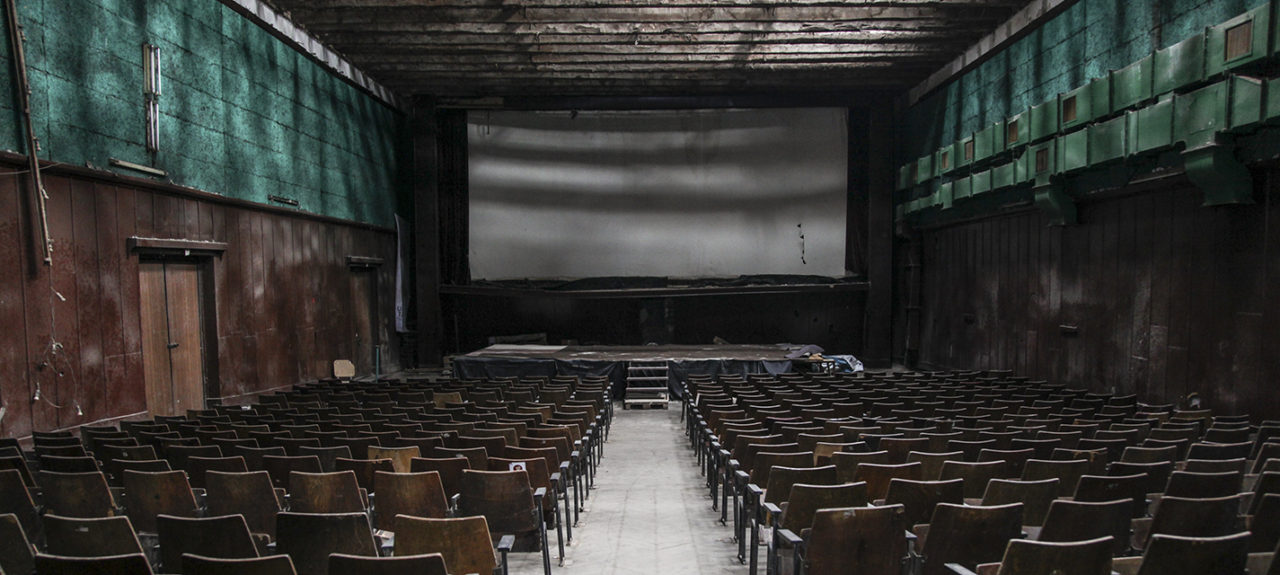
Foto: Majlinda Hoxha / K2.0.
This conversation has been edited for length and clarity. The interview was conducted in Albanian.
Feature image: Majlinda Hoxha / K2.0.








